|
|
|
Running
|
| Running
is the oldest and the most important sport of the
Olympic games. The winner of stadion gave his name to
the Olympiad. It is believed that it was invented by
mythical persons (the well known hero Hercules and the
Kourites and others). Athletes ran with naked feet.
They wore a loin- cloth around their waist and later
they competed naked. According to the history in the
15th Olympic games (720 B.C.) Orsippos from Megara
while running lost his loin–cloth but he continued
naked. He was the winner of this Olympiad. Since then
athletes competed naked. The running contests included: |
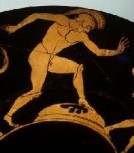 |
The stadion: race of speed or stade race
(600feet or 200m). It covered the Olympia
track from one end to the other (192,28m). The
winner was called stadionikis (winner of
stadion). The first winner of stadion in
Olympia was Korivos from Ilia. Stadion was the
only athletic event until the 13th
Olympiad (728 B.C.).
The diavlos: also race of speed, double-course
race (1200feet or 400m). The diavlos was added to the games in
724B.C. (14th Olympiad).
|
|
|
Dolichos:
(long-course race ranging between 7 and 24 stades). Most times
the distance was determined to 20 stades (3550-3800m). It was
added in the 15th Olympiad (720B.C.).
Race in armour (oplitis dromos): It was added in
the Olympic games in 520B.C. that is the 65th
Olympiad. A race of speed where runners carried a shield, a
helmet, and shin plates. The distance of oplitis dromos was 2 to
4 stades (usually 2 stades as in diavlos). This race is
considered as a funeral to honour a dead hero. This is also
reported in other festivals too (Nemea, Isthmia, Panathinea).
According to Pausanias they used to keep 25 shields made of
copper in the temple of Jupiter at Olympia, which were given to
the athletes for the races.
|
|
|
|
 up up
|
|
|
| The
Pentathlon |
|

|

Halteres
|
It was constituted of five athletic events: jumping,
running, javelin discus throw, and wrestling.
The first three were considered to be light
and the other two hard. Iasonas founded
pentathlon, by joining five different athletic
events to honour his friend Paleas who had won
in wrestling, at the games that the Argonauts
had organized in Limnos. However he was second
at the other events. |
 |
|
|
Jumping, javelin, and discus throw were sports
of pentathlon, while running and wrestling
were carried out separately with their own
trophy. The winner of pentathlon is the
greatest. Aristotelis considers him “the
best of Greeks”. However the way of the
pentathlon winner’s nomination remains
unknown. |
 |
|
|
|
|
 up up
|
|
| The
jumping |
 |
Jumping is mentioned for the first time as
independent athletic event in Odyssea, at the
games of Feakes in honour of Odysseus (129).
It is also part of the games that Argonauts
organized in Limnos. In Olympia it was event
of pentathlon was held in the stadium at a pit
of 50 feet (16m) with four sides and soft sand.
As today, in one side of the pit there was the
springboard where the athletes were standing. |
|
After the jump of the athlete in the point
that his legs leaned, placed the point, in
order to distinguish his record, which they
measured with a wooden stick, the ruler.
Athletes used stone or lead weights called
halteres in order to have better record.Halteres were of different types according to
their shape: elliptical, global and had
different weight, mainly they were long and
globular. Those that were rescued by the
antiquity have weight 1610,1480 or 2018 or
even 4629 grams. Jumpers used the suitable
halteres proportionately their physique.
However it seems that those that were very
heavy were probably donations. Their use
wasn’t obligatory. Athletes also used them
to train the hands, the arms and the fingers,
(said altirovolia) as is shown in various
depictions in vessels. The long jump was
probably simple, double or even triple.
According to testimonies that exist, a flute
player, whose sounds underlined the rhythm and
musical flow of properly executed jump, at
times accompanied the athletes. |
|
|
|
 up up
|
|
| The
discus throw |
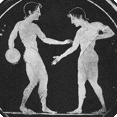 |
It is
mentioned by Homer as one of the games
Achilles, held in honour of Patroclus.
Also Odysseus in Odyssey (th 186) was
the winner of discus throw at the
games Feakes had organized to honour
him. It was called solos in Homer (weight
tightened with a strap thrown as they
throw the hammer in nowadays).
It was
added in Olympic games in 632 B.C. |
|
| and
was an athletic event of pentathlon.
The discus was originally made of
stone, and later of iron, lead or
bronze. They were round as today.
Their diameter was 0,17 to 0,34m their
weight was 1250 to 6600 grams. The
biggest were donations (the discus of
Poplios Asklipiadis from Corinthos,
winner of the 255th
Olympiad in 241A. P.) is kept in the
Olympia’s museum with an engraving
inscription dedicated to Jupiter.
Different depictions of athletes were
engraved on the discus. Other times
odes or various treaties were written
like the treaty of sacred truce at
Olympia. |
 |
The technique was very
similar to today’s discus throw, and
this is obvious by the depictions of
vessels and the statues (The
discobolus
- discus thrower - of Mironas).
The records of the athletes were
marked with beanpoles or nails – the
points- and then the length of
throwing was measured with a pole or a
rope. Athletes used the same discus at
the games. Pausanias mentions
(VI.19.4) that in Olympia three
official discuses were kept at the
treasure of Sikiones for the game of
pentathlon. |
|
|
|
|
 up up
|
|
| The
javelin |
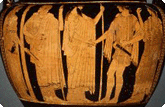 |
It is
mentioned by Homer and has its origin from war
and hunting. There were two events of javelin
throw: one was for distance and the other for
accuracy. The first one was held in Olympia.
The javelin was a long wooden pointed pole
(1,50-2 m.), without metal spearhead and is
lighter than that which used in war. |
|
| Javelins
with spearhead were used at the throw for
accuracy. Athletes attached a thong (leather
strap) that formed a loop, (0,40m. long) at
the centre of gravity of the javelin, to make
the grip more secure and stabilize the javelin
in flight. The technique was very similar to
today’s freestyle discus throw. |
|
|
|
|
 up up
|
|
|
The
wrestling |
 |
It was one of the most beloved sporting events.
Homer describes scenes of wrestling at the
“labours of Patroclus”. Inventors of the
sport are mentioned Thiseas (he competed
Kerkyona) but also Hercules (when he beats the
giants Anteo, Acheloos, Tritonas and various
monsters). However Hermes and his daughter
Palestra are said to be inventors of wrestling. |
| It was added to the Games as a detached sport
but also as an event of pentathlon in the 18th
Olympiad (708B. C.). The boys started
competing in the 37th Olympiad
(632B.C.). There were two events: the standing
wrestling and the rolling one. In the first
one the athlete should knock down his rival
three times while in the second one the
contest continued after the fall and ended
only when one of the contestants admitted
defeat |

The Palestra
in Ancient Olympia
|
| (raised one or two fingers of his hand).
Lot appointed the contestants in pairs (5-8).
They used to spread oil on their body and
competed naked in the pit. Many depictions on
vessels give us information about this sport.
We know the names of famous wrestlers. One of
them was Milon the Krotoniatis who was winner
five times in Olympia, seven in Pythia, nine
in Nemea and ten in Isthmia. |
|
|
|
|
 up up
|
|
| The
boxing |
 |
It is considered as one of the oldest sports, already known in Minoan and
Myceanean era. Homer mentioned it as
one of the games held in honour of
Patroclus. The god Apollo is
considered to be its founder but also
Thiseas and Hercules. It was added to
the games in the 23rd
Olympiad (688B.C.) and for the
participation of the boys in the 41st
(616B.C.). The contestants competed until
one of them was unconscious or
admitted defeat. |
|
| Lot defined the pairs
of the boxers. Many depictions of
vessels showed that the opponents were
standing facing one each other with
the left foot ahead and the right bent.
The knocks were done on the head and
the face. There was no time limit
during the contest, and ended only
when one of the contestants admitted
defeat or fell unconscious. |
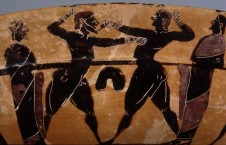
|
|
| Boxers
wore himantes (straps) around their
hands something that was known in
Mycenaean era. They used them to
strengthen their wrists and steady
their fingers. Homer mentioned that
they were made of soft leather of ox.
As time progressed boxers started
using hard leather straps, often
causing the disfiguring of their
opponent’s face (4rdcentury B. C.
until the end of 2ndcentury B. C.). In
roman times boxers used gloves filled
with iron and lead. One of the most
famous boxers was Diagoras the Rodios,
father of Callipateira. |
|
|
|
 up up
|
|
|
| The
Pankratio |
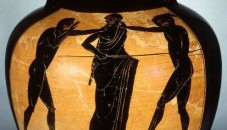 |
It was
one of the most spectacular athletic event combining
wrestling and boxing. Theseus combined these two to
defeat the fierce Minotaur. It was added in the 33rd
Olympiad (648B.C.). There were two events that
involved the Pankration: |
The first one was when the
athletes competed standing and the other when the
opponents fell down and continued. During the training
the athletes used the first one while in the games the
second.
The contestants should combine the
qualifications of both wrestlers and boxers, while
there were strict regulations. The names of famous
athletes were those of Ligdamis from Siracouses (the
first Olympic champion in pankration in 648B.C.) and
Euklis, Sostratos, Sikionios and others |
|
|
|
 up up
|
|
|
| The
equestrian events |
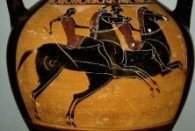 |
They
were added for the first time in the 33rd
Olympiad in 648B. C. when horse races for
yearlings were held. It was an event where the
rider made six laps of the Hippodrome. In
469B.C. (71st Olympiad) the mare
horse races were added (kalpi) and in
256B.C.the horse race for yearlings.The rider
was riding naked without saddle and stirrups
holding the reins |
|
| and
the riding-crop, as it is depicted on various vessels.
Warriors probably used the saddle. The charioteers and
the horse riders were in attendance on the horses’
owners. |
|
|
|
 up up
|
|
|
| The
chariot races |
|
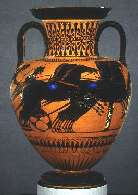
|
The
first race was between Pelops and Oenomaos, king of
Pisas, a myth that is connected with Olympia. It is
also mentioned by Homer as one of the games held in
honour of Patroclus. The god Poseidon is considered to
be the patron of these races. The
chariots races included:
The tethrippon: it was a four-horse
chariot race. The
chariot was a small wooden vehicle with four horses.
The
length of the distance was twelve laps in the
Hippodrome. It was added in the 25th
Olympiad (680B.C.) and is held until 241A.C.). |
The
apene (mule-cart race):
It was added in the 70th Olympiad
(500B.C.) and was abolished in the 84th
Olympiad (444B. C.). There were two mules at the
chariot.
The two-horse chariot race: It was added in
the 93rd Olympiad (408B.C).
The four-horse
chariot race for yearlings: It was added in the 99th
Olympiad (348B.C.) and the distance was eight laps of
the Hippodrome. |
| The two-horse chariot for yearlings:
it was added in the 128th Olympiad (268B. C.)
I n the Homeric era the owner of the horses was the
charioteer, but in the historical era the charioteers
were not the owners. The owners were the winners who
were wreathed while the trophy |
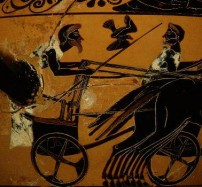 |